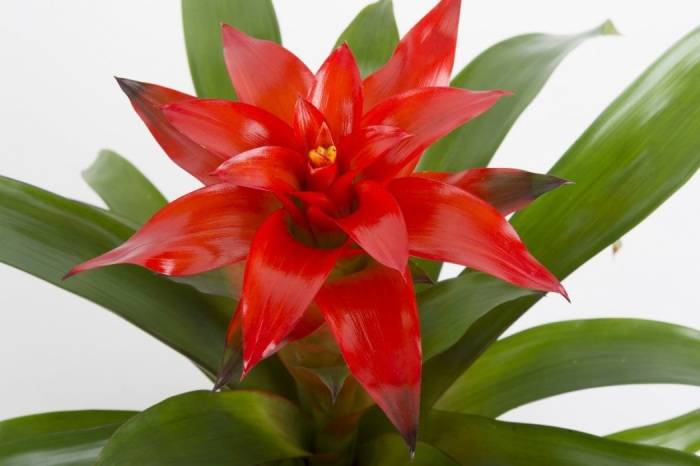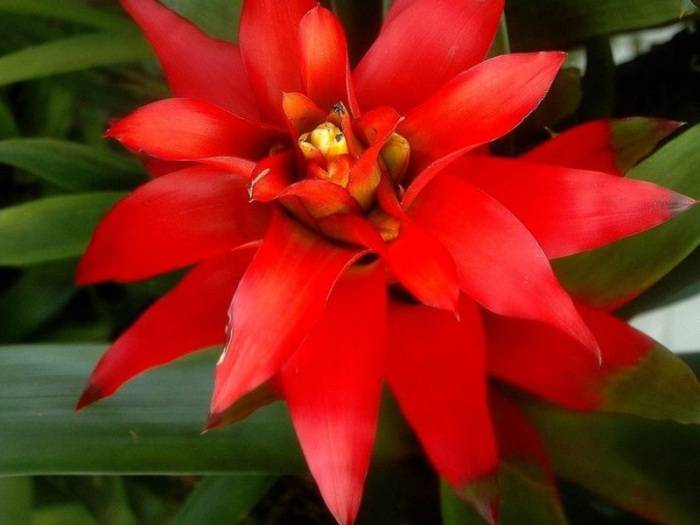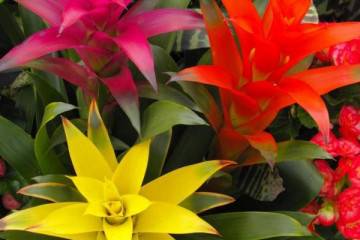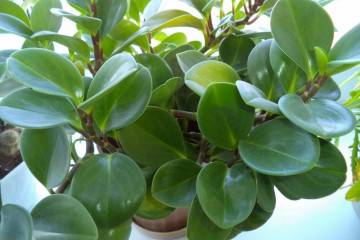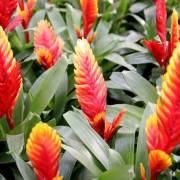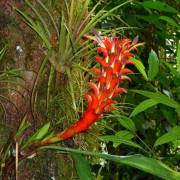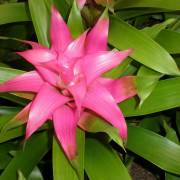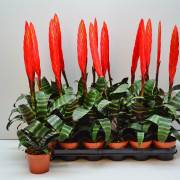Guzmania: plant transplant and home care
Content:
A bright representative of the Bromeliad family, guzmania, is found in South America - in the Bahamas and the Caribbean, Brazil and Venezuela. Some varieties are native to southern Florida and Central America. Refers to alpine evergreen herbaceous plants. Guzmania looks like a flower with red leaves on top. The name Guzmania comes from the name of the explorer of South America, Anastasio Guzman.
Main types
In total, there are about 130 species of guzmania, mostly epiphytes, but there are also terrestrial species. Not all of them can be grown as indoor plants.
Guzmania reed
The Latin name is Guzmania lingulata. The most often grown in the house is a representative of the Guzmaniev family.
Guzmania reed in nature is an epiphyte, a relative of pineapple. It grows on tree trunks, clinging to them with roots. High in the mountains, this plant grows right on the rocks. It receives nutrients with the help of aerial roots. There is no stem, narrow dense leaves form a rosette extending directly from the root.
Light inconspicuous flowers are located at the top of the peduncle. They are surrounded by bright bracts. Many consider them to be petals, but they are simply modified leaves.
The reed variety has long, up to half a meter, bright green leaf plates, collected in a dense rosette. Bracts are scarlet, dark red, orange. The flowers themselves are pale yellow.
Guzmania mosaic
A large representative of the Bromeliad family with a rosette almost a meter in diameter. Leaves of variegated color, with lighter stripes and specks. Bracts of a rich pink or orange hue. Only one peduncle is formed. It blooms from late winter to almost mid-summer.
Tricolor
Bracts and leaves are colored green, red and white. Flowers are yellow, three-petaled, set low in a leaf rosette.
Guzmania blood red
A small flower with a rosette up to 30 cm in diameter. During flowering, from mid-spring to late summer, almost all the foliage turns red, not just the bracts. The blood-red guzmania has species with purple and crimson bracts. The petals are cream colored.
Ostara
A hybrid with a half-year flowering period, after which the mother plant dies, but numerous children remain. Bracts are red-orange. The foliage is glossy, dense. Named after the ancient German goddess of spring.
Guzmania Donella Smith
Inflorescence of complex shape. Bracts are red and yellow, sometimes white, leaves are scaly.
Guzmania mix
Often in stores on price tags you can see the name "Guzmania Mix". Novice flower lovers need to understand that this is not a separate variety, but a mixture of seeds of several plant species.
Home care
Long-term flowering can be achieved only by providing the correct step-by-step care, observing the requirements for lighting, watering, temperature, land for guzmania.
The flower is not only decorative, but also useful. Epiphyte is able to "attract" dust in the process of extraction of useful substances by aerial roots.Thus, the amount of dust in the air is reduced, which is very beneficial for people with respiratory diseases and allergies.
Temperature
Guzmania likes moderation in temperature. Both extreme heat and cold are not welcome. In winter, during the dormant period, the room where the flower grows should not be lower than +15 ° C. With a cooler "climate" in the room, the epiphyte can fade ahead of time and even rot. Optimum for growth will be + 17 ... + 19 degrees.
In summer, it should not be hotter than + 27 ° C, otherwise the leaves will begin to dry.
Illumination
Guzmania grows under the canopy of a tropical forest, where only scattered sunlight penetrates. Therefore, at home, you need to create a similar atmosphere.
You can not put the flower in the open sun, it is fraught with burns on the leaves. Better to choose a window facing east or west, where the sun is only part of the day.
At the same time, it is also not worth shading too much. If the question arose why the guzmania does not bloom, then most likely it is necessary to transfer it to a more illuminated place.
Fertilizers
The choice can be stopped on both organic and mineral fertilizers for the Bromeliad family. They can be found in many houseplant stores. Before buying, you need to consult with the seller.
Too strong concentration is always indicated on the packaging with preparations for feeding. For guzmania, it is better to use half the dose specified in the fertilizer instructions. Top dressing is applied once a month, from March to September.
The diluted drug is not introduced into the soil, but into the very outlet of the plant. Watering is carried out at the same time.
The soil
You can prepare the soil for guzmania yourself. For this, chopped bark is taken - pieces not larger than 10 mm. No more than 5% of charcoal is added to it.
Before planting an epiphyte, it is imperative to check the acidity of the soil, it should not exceed 7.0 pH.
You can buy ready-made potting mix. To know exactly which soil is suitable for guzmania, you can consult with the seller. But most often it is called “For bromeliads”. A light, air-permeable and moisture-permeable substrate is what you need for a guzmania flower. Transplantation can also be carried out into the soil "For Saintpaulias". Their composition is different, but many growers successfully grow bromeliads in such a substrate.
Drainage is always poured at the bottom of the pot.
Whichever soil you choose, you need to get rid of potential parasites by calcining it in the oven.
Watering
They are watered not at the root, but in the rosette of leaves. As in nature, as if it were raining.
When watering under the leaves, the root system can rot. If the soil for the plant is made of charcoal and bark, then watered daily. The frequency of watering with a purchased substrate is selected individually, it should not dry out. As a rule, this is 2-3 times a week. At low temperatures, watering is reduced.
The water is taken filtered from chlorine. Temperature - not lower than 20 ° C.
The plant is sprayed daily. If the tap water is not too chlorinated, then a self-grown plant can even be washed with warm water using a shower.
Transfer
Each new owner wants to know how to transplant guzmania at home correctly so that it does not die and subsequently pleases with a beautiful flowering.
So, Guzmania does not need a transplant immediately after purchase. Only if the soil does not fit at all or the planter is damaged.
To select a pot for a transplant, the following rules must be observed.
- The material of the pots does not matter.Therefore, you can plant guzmania in both ceramic and plastic pots. You can organize a pots from a fragment of a tree trunk. Epiphyte will only delight you and will look more decorative than an ordinary flower pot.
- The size of the container for transplanting guzmania should not be too large. This is due to the small root system of the plant. The diameter of the pot is matched to the roots.
- The ideal transplant container should have a drainage hole where excess moisture will drain.
Guzmania pots often fall off due to the shape of this plant. Therefore, so that the flower does not tilt to the other side, you need to put it in a heavy ceramic planter. But at the same time, it will be necessary to constantly drain the water, preventing its stagnation and the beginning of the decay process.
Bloom feature
Flowering occurs at different times depending on the variety. Approximately - from the end of February to September. Hybrid varieties bloom for six months. But even simple guzmania will delight their owner with 2-3 months of bright bracts.
The peculiarity of flowering is that it is one-time. After flowering, the guzmania dies, but before that, processes appear on it.
Reproduction methods
How does Guzmania breed? There are two ways: by shoots and by seeds.
Seeds
Reproduction by seeds is more difficult than by shoots, but it is also possible, contrary to the opinion spread by some growers.
Seeds are sown on the soil of tree bark or peat and covered with foil or glass. They do not sprinkle with soil; for germination, access to light is needed. The soil is moistened with a spray bottle.
Seeds sprout quickly, after 2-3 weeks. Two-month-old sprouts can be transplanted into soil from peat, leaf and turf soil.
By shoots
The easiest way to propagate epiphytes. A faded plant forms babies.
Often, a novice florist is concerned about the question of how to plant guzmania and its layers? To do this, after the flowers have fallen, the babies are simply separated from the dying mother plant. The length of the "baby" roots should reach one and a half cm.
Separation from the mother plant is done with a sharp, disinfected knife. The cut is immediately sprinkled with charcoal or covered with garden pitch.
The separated layers are transplanted into permanent soil under a bag or glass cover.
Thus, guzmania is a highly decorative plant. It is also suitable for a novice florist, since the rules for caring for her are simple. But it is worth remembering that after flowering, the guzmania will always die, it is impossible to preserve it.

